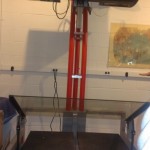From July 21st to the 23rd I had the opportunity to attend the Northeast Document Conservation Center (NEDCC) sponsored Digital Directions; Fundamentals of Creating and Managing Digital Collections conference on the campus of the University of Michigan, Ann Arbor. Along with the friendly people, good eats, and plenty of bookstores, I was able to network and engage with people about digital issues in its many forms. There were people who were “experts” in the field, to those who were just getting started in the process. Find the conference program here.
The first day was a lot of theory and guidelines about various issues for digital collections. It was quite overwhelming at some points, with a lot of resources and terms being given. Day two comprised of breakout sessions, where I focused on digital collections, digital preservation, metadata, digital repositories, and cloud. Day three focused on collaboration within your institution, specifically between IT and the library and externally. One of the main idea from day three was beneficial partnerships and that all project partners big and small bring something valuable to the table.
On the third day attendees had the opportunity to tour two of the labs on the U of M campus: Tour of University of Michigan Digital Conversion Unit or of the Technology Lab. I did the tour of the conversion unit, which was quite impressive and I was glad to see that they have the same Epson 11000XL that we have at Chicago State. See images below.
- Lara Unger, Digital Conversion Supervisor, Digital Library Production Services, showing us items that could not be scanned by Google, so they have to scanned inhouse
- One of the scanners they use
- One of the scanners that they use
During the informal breaks I had the opportunity to talk about our project (and to pass out the cards) and everyone I spoke to about it was impressed. Some had heard about it and others were interested in learning more. One of the archivists that I talked to mentioned that it was hard within her state to get people to work together, so she was interested in know how we formed and the responsibilities of each institution.
Conference Takeways
- Know your institution, in terms of risk management (is some loss acceptable to you? who will be doing the metadata, how specific will it be?), budget, staffing (who responsibility is what), formats, mission, etc.
- It does not take much to get started with digital preservation-every little bit helps
- You really cannot do it alone (get assistance at every stage of the process)
- Modify standards, guidelines, and best practices to your institution, sometimes just good enough works
- Make your metadata interoperable and specific (ex. downstate and Illinois versus just downstate), so that when you merge records it is clear
- Approach stakeholders with a tailored message this can be done through workshops and one-on-one sessions. When involving IT, do not let them take over the project, this is your territory.
- Assessment of digital collections has to be done, either qualitative or quantitative.
- Document what you have done to the collections so that 1) those in the future can know and 2) that data was not lost in the transitions (bit count)

- Within the conversation of digital preservation we need to make clear the difference between preservation and access copies
- Learned more about the environment that digitization should be taking place in, in terms of lighting, monitors, and equipment.
I think that it is interesting and important to point out that while there was diversity within the conference attendees, it seemed to me that I was the only (if not, I apologize) attendee from a predominately African American university. This is why I think that CSU’s involvement can demonstrate the importance of not just digitizing and providing access to collections about African Americans, but also for the long term preservation of it for future generations.
One of the highlights (in addition to the conference) was exploring the campus libraries and talking with the Outreach Archivist in their Special Collections. To me it is always nice to see how their special collections are set up and what kinds of programming they do.
If you will excuse my metaphors, digital preservation is like this cube in a couple of ways
- It only takes a little push to get rolling, and
- You have to look at it from several angles
Please add your metaphor in the comments.
Post written by Aaisha Haykal, University Archivist, Chicago State University.









2 comments
1 ping
Spot on with this write-up, I honestly believe that this website needs much more attention. I’ll probably be back again to read through more, thanks for
the information!
Pretty interesting and insightful content.
Bookmarked , I appreciate the excellent read.
[…] The original POWRR blog post can be found here. […]